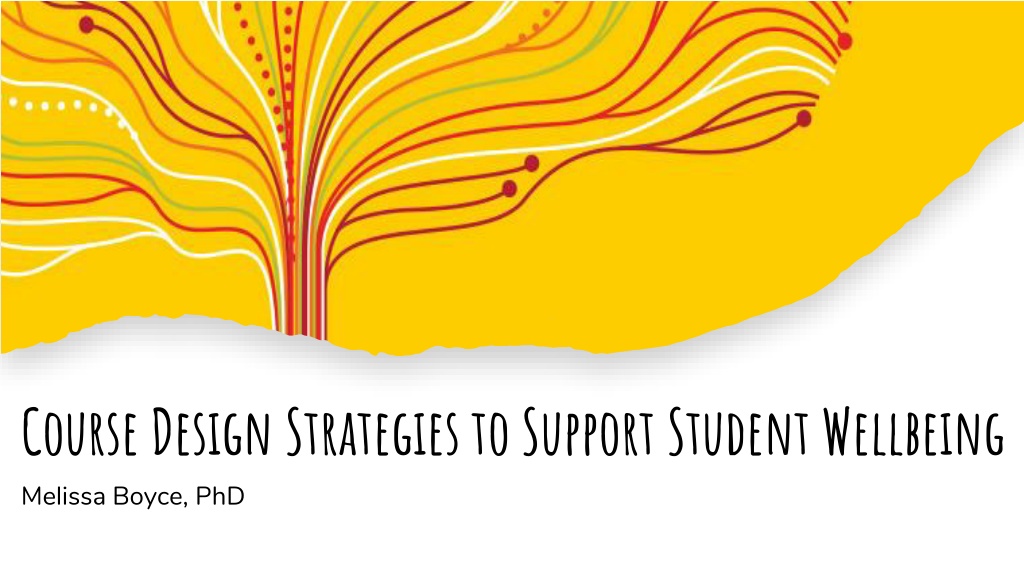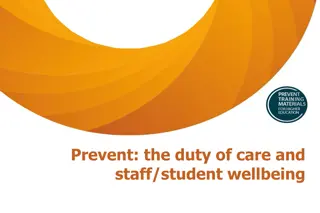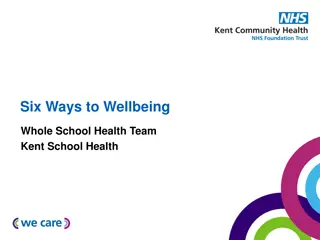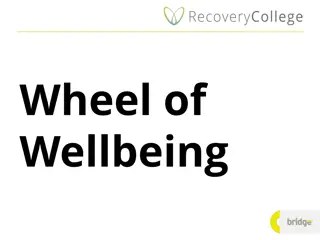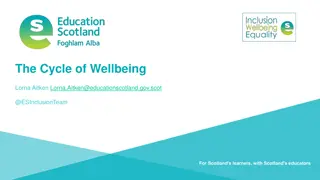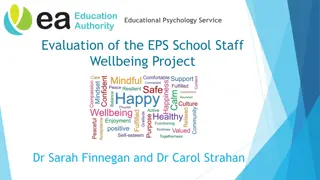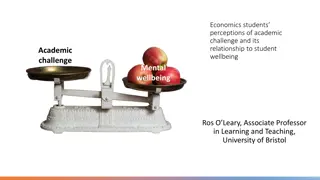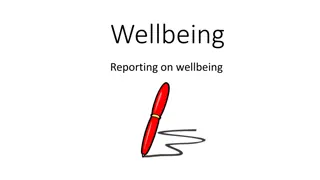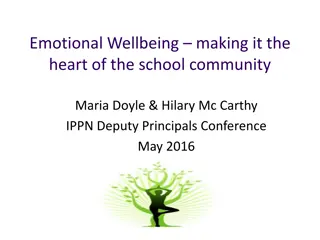Strategies for Enhancing Student Wellbeing in Higher Education
Explore course design strategies to promote student wellbeing in post-secondary education, addressing common stressors and factors impacting mental health. Insights from a needs assessment shed light on enhancing teaching practices and academic policies for student support.
Download Presentation

Please find below an Image/Link to download the presentation.
The content on the website is provided AS IS for your information and personal use only. It may not be sold, licensed, or shared on other websites without obtaining consent from the author. Download presentation by click this link. If you encounter any issues during the download, it is possible that the publisher has removed the file from their server.
E N D
Presentation Transcript
Course Design Strategies to Support Student Wellbeing Melissa Boyce, PhD
Post-Secondary Mental Health Context Mental health crisis for students Over the last 30 days, most undergraduate students expressed feeling: Lonely (54%) Moderate or high levels of stress (80%) Moderate or severe psychological distress (75%) 2 ACHA/NCHA, 2021
Causes of Student Stress Most common stressors identified as causing moderate or high distress 1. Academics (89%) 2. Finances (76%) 3. Death of family member, friend, or close other (74%) 4. Career (73%) 5. Procrastination (69%) 6. Family and/or Intimate Relationships (66%) 3 ACHA/NCHA, 2021
? What should instructors focus on to promote student wellbeing through course design and teaching practices?
Strengths and Needs Assessment Quantitative survey conducted of UCalgary students in Summer 2020 Follow-up qualitative interviews completed during the Fall 2020 term Key interview questions included: What do you think are the factor(s) that promote mental health and wellbeing in the teaching and learning context? What do you think can be done to improve academic policies and processes that create challenges and are common sources of students stress? 5 Lindsay, Bernier, Boman, & Boyce, in press
When you overload people and don't give them enough time to absorb the material, then how can that be good for them in any way? You know, I understand that there is some goodness to pushing yourself. And there's kind of a sweet spot with people right, where, you know they should be a little bit challenged in whatever they're doing to grow, right? 6
I think that instructors need to be educated that not everybody learns the same way and not everybody sort of handles stress the same way. 7
1. Prioritize everyone s mental health
1. Prioritize everyones mental health: strategies Create clear and accessible options for how to request extensions/deferrals Align weight of assessments with estimated time it will take students to prepare for and complete them Coordinate timing of assessments across required courses in a program Provide a late bank option Routinely check in with students to see how they are doing 9
Another thing would also be, I find getting information from the university is just very difficult to do. So, I had spent like probably days searching for information because I will go through one of the offices and they'll tell me, "Oh, we're not too sure". Or Oh, you actually have to check with this person or check with this person" or you call someone and they don't know who you're supposed to talk to. 10
The other thing would be, the other thing would be like, I guess increasing maybe resources for students, like maybe find a place to study if they can't really do something at home, because a lot of it comes down to like, not having an ideal test-taking environment, or a place to like do your schoolwork for a lot of people. So there's even that factor to consider. 11
2. Provide and guide to accessible supports
2. Provide and guide to accessible supports: resources Learn and share available supports widely: Student Accessibility Services: https://www.ucalgary.ca/student-services/access Student Success Centre: https://www.ucalgary.ca/student-services/student-success Student Wellness Services: https://www.ucalgary.ca/wellness-services/services/mental-health-services After-hours supports (available 24/7): Calgary Distress Centre: 403-266-4357 Wood s Homes: 403-299-9699 or 1-800-563-6106 Share options and processes with students: EWs and DFTs and DFEs Keep this handy!: https://www.ucalgary.ca/live-uc-ucalgary-site/sites/default/files/teams/1/2019_students-distress.pdf 13
Maybe more awareness and trying to remove the stigma that's attached to it. The university has been doing stuff around mental health awareness, but it still has a stigma. So it is to find a way to maybe bring it across to students to understand that there is nothing to be ashamed of. And it's okay to seek support if you need it. 14
So whatever their mental health concern might be, just sort of education on what it looks like and showing people that there isn't one way that mental health presents itself and also education on what treatment can look like So just stuff that informs people of that, the basic information about what these things are and what you can do to sort of ameliorate some of the effects. 15
3. Increase mental health literacy
3. Increase mental health literacy Discuss the importance of self check-ins, help seeking, and talking about mental health Review the mental health continuum with the class to help them self-reflect on their wellbeing: https://theworkingmind.ca/sites/default/files/resources/r2mr_poster_en.pdf Discuss (or practice!) empirically supported coping strategies in class 17
I would say one of them would probably be just in terms of students in general, social support. So that's, just having other students that you can talk to about - like being able to talk about what you're thinking, get stuff off your mind. And that's honestly really important for mental health. So, I would say for having those groups in place or having a person that you can talk to. 18
In relation to school, I think a lot of my stress is not understanding assignments or not understanding the materials. So if you can reduce that stress by being able to ask questions, and that increases, you know, how comfortable you are in class. So it increases mental health. 19
4. Foster connections and social support
4. Foster connections and social support: Strategies Work with your class to establish and adhere to norms within the learning community Make time for social moments in class Obtain anonymous mid-course positive and constructive feedback on learning experiences Build accountable teamwork into your course 21
I think maybe we should have less of a focus on the ability to perform within a time limited period and more the ability to perform well in accordance with what your degree is being used for and how you can apply that to, you know, real world situations. 22
So I think considering students' ideas about structuring the course would help them because then they can kind of adopt to their own schedule, which supports mental health and wellbeing. I think when you have your own ability to have a bit more flexibility in your schedule. 23
5. Strengthen best practices in teaching and learning
5. Strengthen best practices in t&l: Strategies Build Universal Design for Learning into your course: https://taylorinstitute.ucalgary.ca/resources/universal-design-learning-higher-education Consider linked assignments that build on one another with feedback Provide explicit grading criteria for assessments Provide opportunities for students to give feedback and seek clarity Build student choice into assessments Build classroom assessment techniques into your course 25
Thanks! Any questions? You can find me at: mboyce@ucalgary.ca 26
